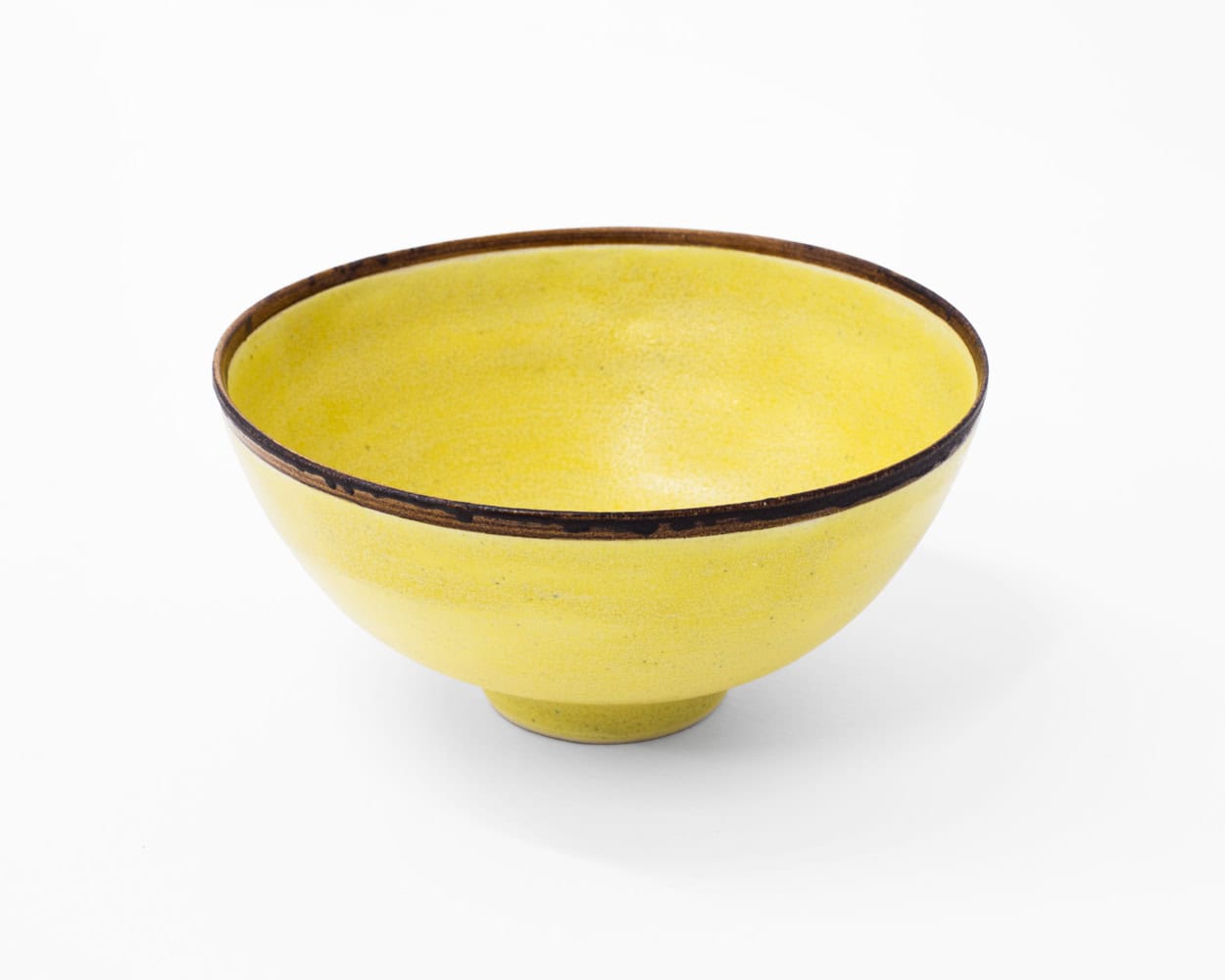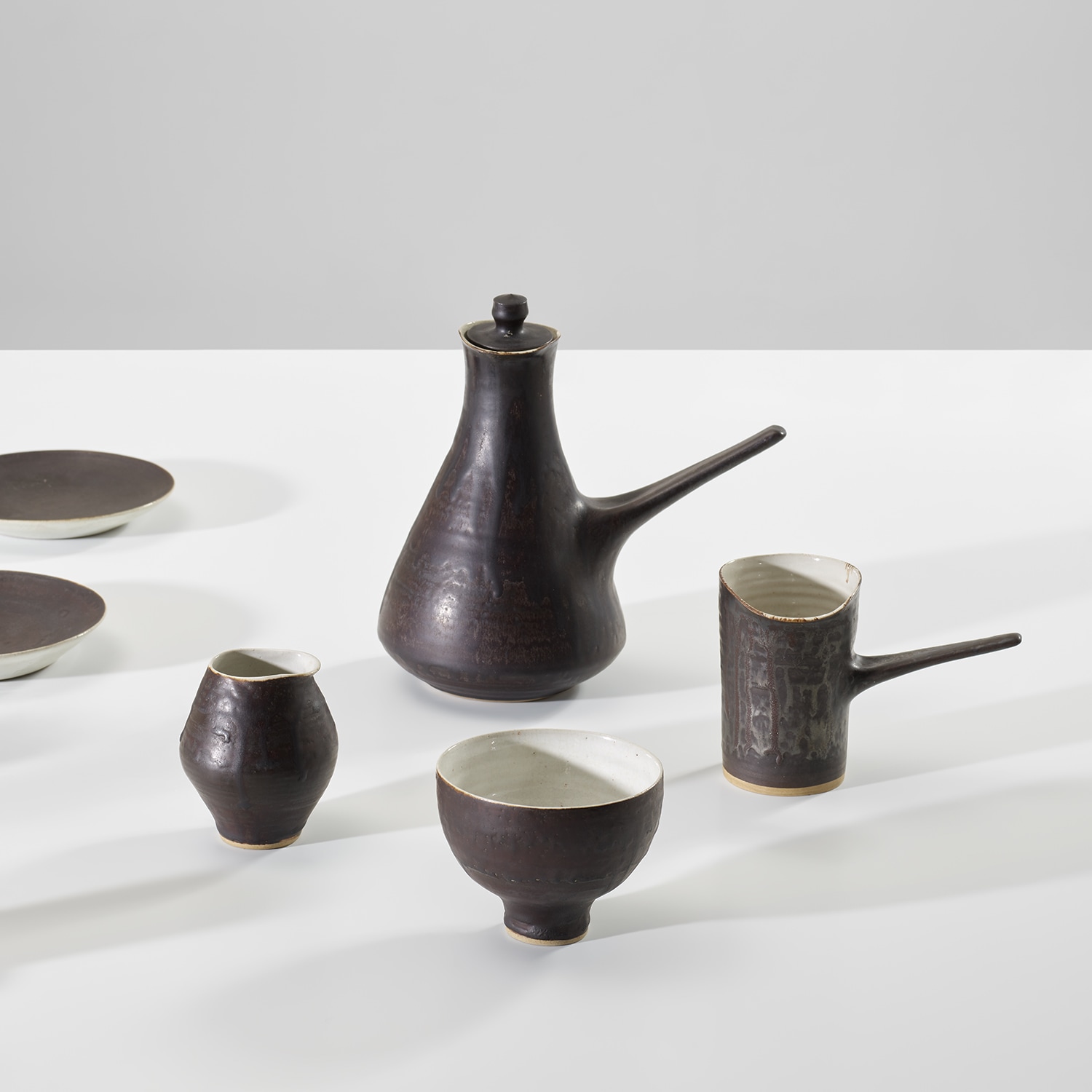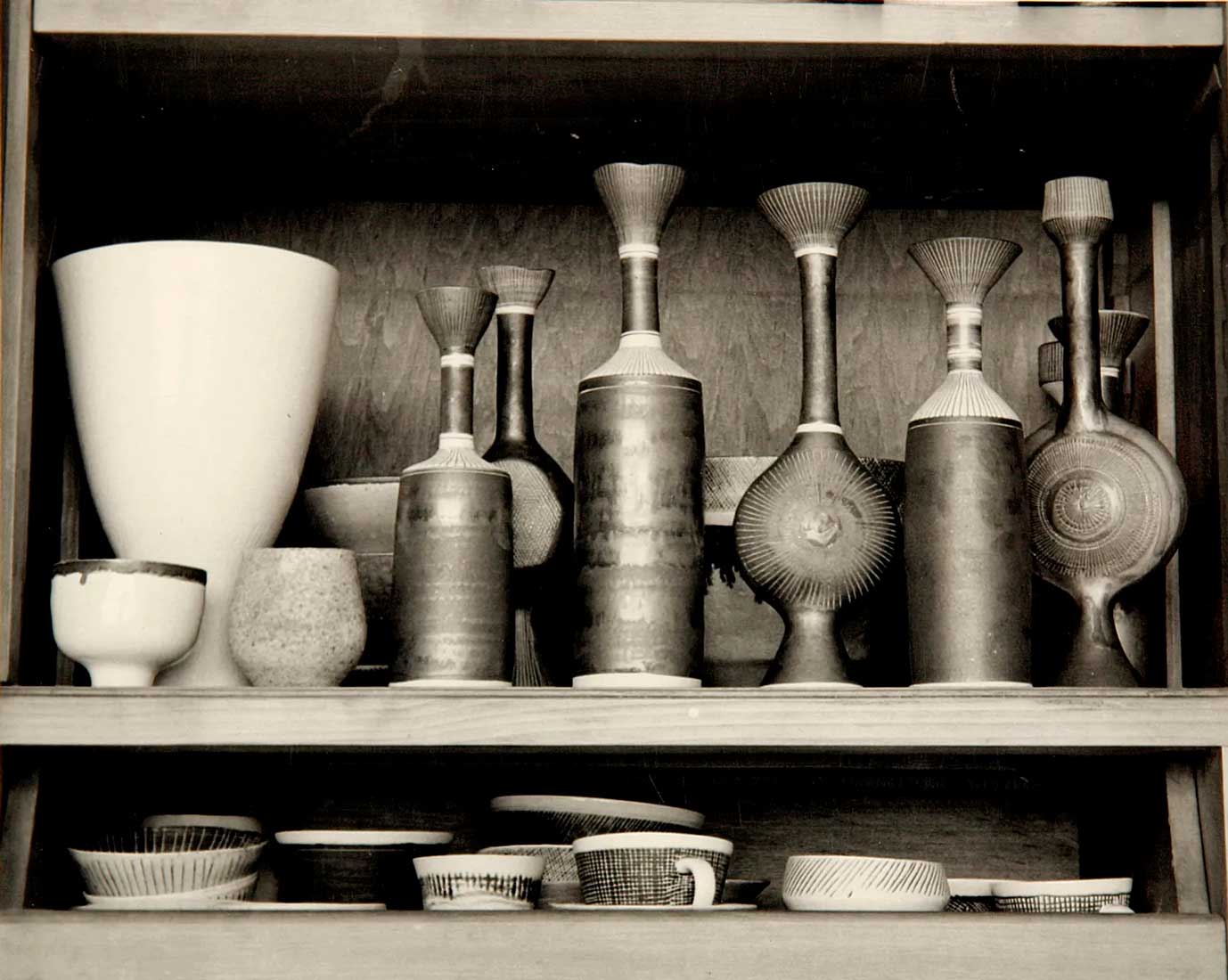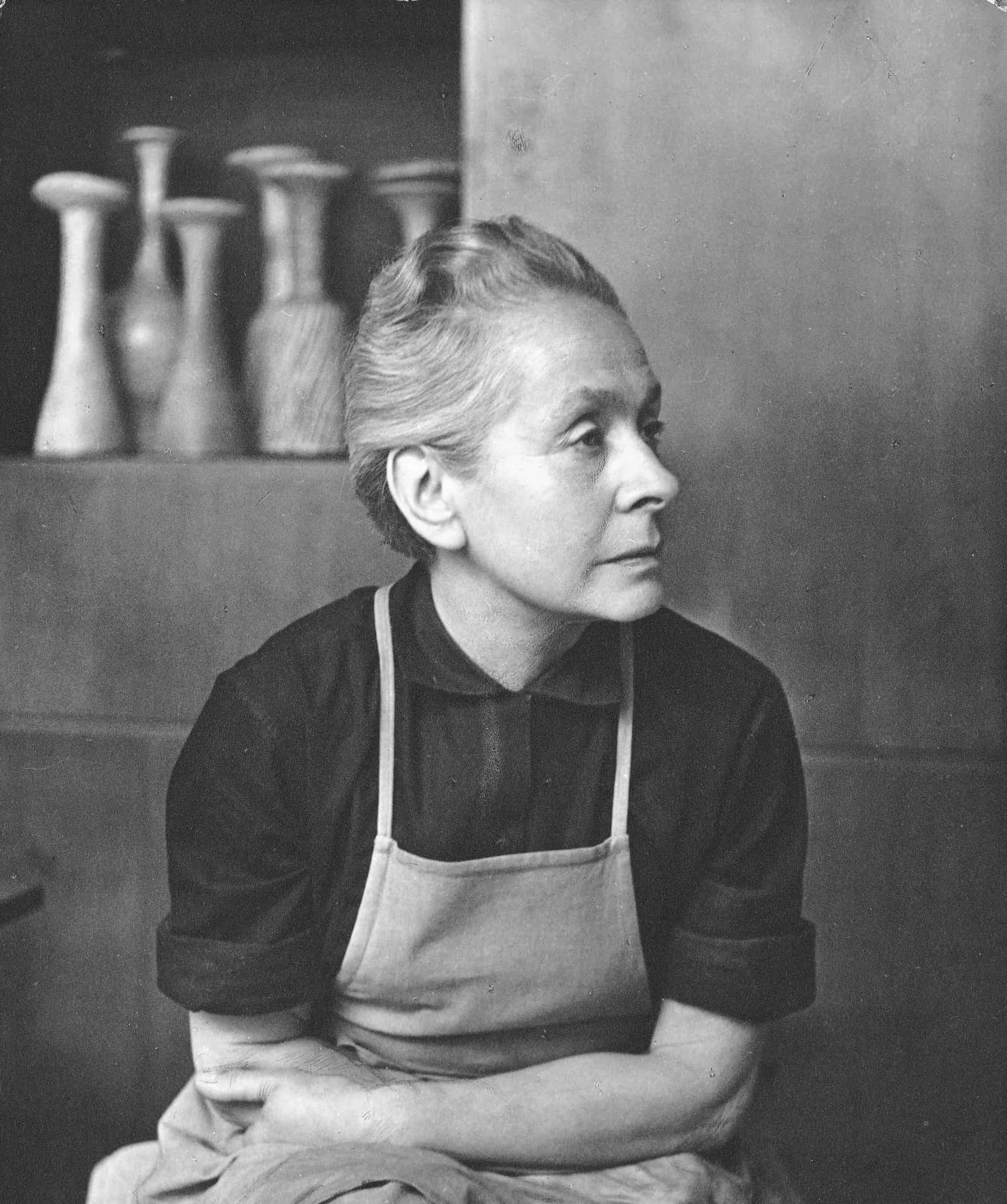Lucie Rie:Footed Bowl
c. 1968
Impressed with artist’s seal
Porcelain, matte yellow glaze with manganese rim
3 x 6 1/2 inches

Art alive is always modern.
Lucie Rie
While pottery and ceramics now pepper museums and galleries in Britain, during the 1930s and 1940s very few people understood pottery making as an artform. British studio pottery was dominated by the aesthetics and practices that honed the historic craft’s traditions of medieval British and Japanese ceramic aesthetics, exemplified in the work of potter Bernard Leach. In contrast to her contemporaries, while championing a female-led studio in a male-dominated practice, Lucie Rie’s style marked a departure from traditional decorative practice. Inspired by a different, Greco-Roman form of antiquity, Rie’s practice was deeply intertwined with Modernist aesthetics and architectures—stripped back from over-decoration and made as one-off pieces. Her career-spanning fascination with form and experimentation led to visually striking works with intentional aesthetic simplicity, shaping the landscape of British ceramic practice in the process.

The artist created a unique seal to authenticate her works, which she would impress into each piece made in her studio.
While her inspirations and practices were broad, Rie always maintained her Modernist sensibilities; ‘Art alive is always modern,’ she wrote. Contemporary architecture and avant-garde Modernism formed much of her inspiration, and her pots display a fascination with form and line. Throughout her oeuvre, an aesthetic simplicity and lucidity is maintained, betraying her acute consciousness of Modernist tastes. Although she didn’t regard her pottery as ‘art’, Rie nevertheless significantly contributed to the canon of twentieth-century cultural production.
Footed Bowl exemplifies this. Its simplicity of form and line, married seamlessly with a bold use of colour, and combined with its small, delicate scale, make it a distinctly Modernist.
More Info
EnquireIN CONTEXT

At the outbreak of the Second World War, Lucie Rie emigrated to London. While her output of pottery decreased, she filled her time by creating buttons, some of which were used for the war effort. Pictured here are some of Rie’s buttons, which, while wholly utilitarian, retain the elegance and fascination with colour that characterises her later works.

Rie’s advice to her students at the Camberwell School of Arts and Crafts was to create teapots ‘for discipline’. The simplicity of structure and line often found in tableware, combined with utilitarian essence, appealed to the potter. Rie was largely occupied with creating teapots and mugs during the 1920s and 1930s, and throughout her career remained faithful to the philosophy gained during that period.

The repetition of certain styles and techniques is a hallmark of Rie’s oeuvre. The potter frequently exercised her interest in aesthetic styles by repeating the same forms time and again, experimenting and nuancing each pot while turning or firing. This photograph, taken in her London studio, shows the influence of varied styles on Rie’s practice. In particular her fascination with classical antiquity; necks are extended, bodies slender or distended, with rims flared, decorated with sgraffito. Beside the distinctly more Modernist vases to the left, Rie’s stylistic eclecticism is thrown into relief.

When producing her works, Rie always remained cognisant of how they might exist in relation to space and architecture. While many of her pots were destined for Modernist homes, accordingly formed through simple, refined lines, other works appear created with rusticity in mind. Rie’s versatility in her craftsmanship afforded her works this variety of destinations.

B. Austria1902-1995
Biography
Lucie Rie’s groundbreaking practice is defined by a refined clarity and simple, utilitarian forms. Rie’s ceramics are characterised by paradoxical dualities: functional and decorative; light and dark; economic and precious. In describing her affinity with pottery, Rie noted that ‘there is nothing sensational about it, only a silent grandeur and quietness.’
Austrian-born, Rie trained in ceramics in Vienna, but her reputation is largely defined by the period after 1938 when she emigrated to London to escape Nazi persecution and established a studio in Marble Arch. One of only a small number of female studio potters working in post-war Britain, Rie pioneered new ceramic techniques, most notably her distinctive raw glazing. Her ceramics unusually fit within traditions of modernist architecture and design, as opposed to craft, but incorporate subtle irregularities and variations that reveal their organic character.
Lucie Rie, born 1902, studied at the School of Arts and Crafts in her native Vienna. Her studio was formed in 1925, and in the same year she exhibited at the Paris International Exhibition. In 1937, she won a silver medal at the Paris International Exhibition. After emigrating to the United Kingdom in 1938, she created buttons as a contribution to the Allies’ war effort, and did not resume potting until 1946. Her first solo show was in London, 1949. In 1951, Rie exhibited at the Festival of Britain and the Milan Triennale. She began teaching at Camberwell School of Arts and Crafts in 1958, eventually retiring from teaching in 1972. The Arts Council of Great Britain staged a retrospective of her work in London, 1967, and in the same year Rie and her long-term friend and collaborator, Hans Coper, exhibited at the Museum Boijmans Van Beuningen, Rotterdam. She enjoyed another retrospective organised by the Arts Council in 1981, which was shown at the Sainsbury Centre, Norwich, and the Victoria and Albert Museum, London. In 1994, works by Rie and Coper were exhibited at the Metropolitan Museum of Art, New York. Her works are held in collections internationally, including the National Museum of Wales, Cardiff, the Museum of Modern Art, New York, the Carnegie Museum of Art, Pittsburgh, Victoria and Albert Museum, London, The British Council Collection, and the Fitzwilliam Museum, Cambridge. Rie died in 1995.
